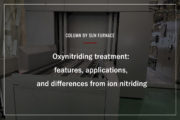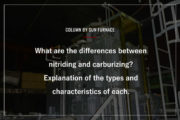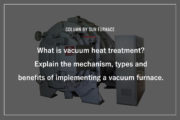We have designed and manufactured over 1500 industrial furnaces, catering to various industries such as automotive, steel, and chemical. With extensive experience and a proven track record in a wide range of furnace types, we offer a diverse range of solutions. In addition to industrial furnaces, we provide total support for related equipment and conveyors, and have successfully tackled a multitude of challenges based on different specifications and needs.
What is carburizing process? Explanation of the characteristics of carburizing, types of carburizing processes and their main features.
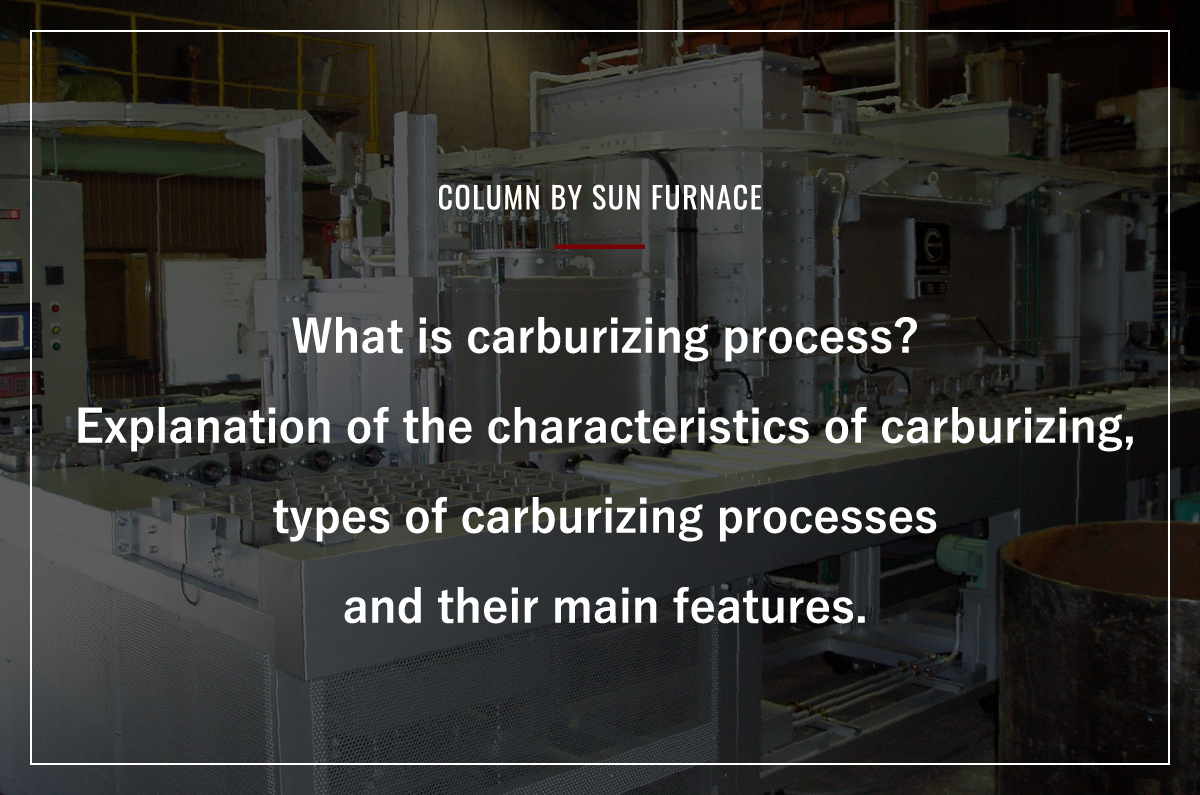
Carburizing treatment is mainly used to increase the surface hardness of low-carbon steel and improve wear resistance.
Metals subjected to carburizing treatment experience an increase in carbon structure on the surface, resulting in surface hardening when followed by quenching and tempering processes.
In addition, the internal hardness doesn’t increase as much as the hardened surface, ensuring toughness. This unique combination provides surface wear resistance and internal resistance to indentation, making the material less susceptible to breakage upon impact.
In this article, we look at the carburizing treatment that is widely used for heavy machinery and mechanical components. We focus on explaining its characteristics, different types, applications, and also introduce special forms of carburizing treatment.
目次
What is carburizing process
Carburizing is the process of heating steel to high temperatures in an atmosphere of carburizing gas. This allows carbon to penetrate the surface of the steel and diffuse into the interior to form a solid solution.
In many cases, carburized steel is subsequently quenched and tempered.
When carbon steel is heated to elevated temperatures, its structure changes to austenite. Carbon from the carburizing gas atmosphere infiltrates the interior. During the subsequent quenching phase, the surface becomes hard while the interior retains a lower carbon content than the hardened surface, resulting in retained toughness.
This process improves wear resistance without compromising impact resistance by maintaining a flexible structure.
However, the surface hardness increases in proportion to the carbon content of the steel. When the surface carbon content exceeds about 0.8%, residual austenite increases during quenching, resulting in reduced hardening. To overcome this, carburizing is performed to achieve a surface carbon content of approximately 0.8%.
Carburizing is a prominent method among surface hardening techniques and is widely used in products that require high rigidity, such as automotive and machinery components. In particular, it is used for power transmission components such as gears and shafts that require wear and fatigue resistance, as well as for engines, clutches and transmissions.
Differences from nitriding
Among the representative heat treatments for steel, in addition to carburizing treatment, there is nitriding treatment.
Both involve heating the surface of the steel, but they differ in the process of diffusion and penetration. In nitriding, nitrogen diffuses and penetrates the steel surface, while in carburizing, carbon diffuses and penetrates.
Both processes increase the surface hardness of the steel, resulting in improved wear resistance. As a result, they are used in components exposed to continuous friction, such as engine parts in automobiles and bearings in machinery.
However, due to differences in surface hardness and dimensional accuracy, the choice of treatment method depends on the intended use of the component.
Carburizing treatment is carried out at relatively high temperatures, ranging from 850℃ to 1050℃, while nitriding treatment is carried out at 400℃ to 600℃.
The higher temperature of the carburizing treatment results in a deeper effective hardening layer and excellent impact resistance. However, there is a possibility of material deformation at elevated temperatures. Components subject to impact, such as engine or clutch parts and machine bearings, benefit from this exceptional impact resistance.
Nitriding, which is performed at lower temperatures than carburizing, is more suitable for components that require minimal deformation and precision.
On the other hand, the depth of the hardening layer is limited to about 0.1 mm. As a result, it is used in applications such as engine cylinders, pumps, compressors where significant impact is not expected.
| Effective hardening layer[mm] | Hardness[HV] | Temperature[℃] | Distortion | |
| Carburizing | 0.5~2.0 | 620~780 | 850~1050 | Large |
| Nitriding | 0.1~0.5 | 1000 | 400~600 | Small |
About carburized structure
The metal structure after carburizing involves the diffusion and penetration of carbon from the surface to the interior of the treated material. As a result, there are differences in the structure between the surface and the interior. In addition, factors such as the inherent strength of the material, hardness during heat treatment, cooling and quenching also influence the structure of the carburized layer.
Hardness of the carburized layer
The hardness of the carburized layer is proportional to the amount of carbon dissolved in the austenite. Increasing carbon content results in greater hardening, but once a certain proportion is exceeded, hardening decreases. Depending on the type of steel, when the carbon concentration (carbon content) exceeds 0.5 to 0.8%, a significant amount of retained austenite is generated, resulting in reduced surface hardness.
To achieve higher surface hardness in the treated layer, it is essential to achieve an optimum surface carbon content without excessive retained austenite.
Depth of carburized layer
The depth of the carburized layer is called the effective case depth and is defined as the distance from the surface to a hardness of 550HV in the Pickering hardness test. Case depth and effective case depth are not necessarily the same; they vary depending on the characteristics of the material being treated, the carburizing process, and the quenching conditions. In addition, deviations in the set carbon concentration, carburizing temperature, inadequate holding time, and uneven furnace temperature can result in failure to achieve target values.
The generally accepted setting for carbon content at the effective case depth is 0.4%, which serves as a reference point.
Carburizing temperature
The carburizing temperature is generally within the range of 900 to 950℃; however, it can be adjusted according to the purpose and application.
The carburizing cycle consists of carburizing time and diffusion time.
There are cases of shortening the carburizing time for high temperature treatment or adjusting the carburizing depth for low temperature treatment. However, if the temperature exceeds 980℃, there is a possibility of coarsening the grain of the material.
Applicable steel grades
In terms of the mechanical properties expected from carburizing, the carburized part exhibits hardened wear resistance, while the center exhibits impact toughness. As specified in the Japanese Industrial Standard (JIS B 6914), there is a wide range of steel types suitable for carburizing. Common choices include steels with a carbon content of 0.2% and H-steel, also known as quenched and tempered steel.
Types of carburizing processes and their characteristics
There are various types of carburizing processes, but the representative methods are as follows.
- Gas carburizing
- Solid carburizing
- Liquid carburizing
- Dripping carburizing
- Vacuum carburizing
- Plasma carburizing
- High carbon carburizing
Let’s look at the characteristics of each of these methods.
Gas carburizing
Gas carburizing is the most commonly used carburizing process that utilizes a carburizing gas atmosphere. Hydrocarbon-based raw gases, such as propane or butane, are mixed with air to produce an endothermic gas that is introduced into the carburizing furnace. The resulting gas is called the carrier gas.
Features of gas carburizing include:
- Easy adjustment of carbon concentration.
- Produces uniform surface structures.
- Suitable for mass production.
The carburizing temperature is generally set between 900 and 950℃, although it’s sometimes increased to around 1000℃ to achieve deeper carburized layers. Increasing the processing temperature allows for shorter processing times, but exceeding 980℃ can lead to the possibility of grain coarsening in the treated parts.
Solid carburizing
Solid carburizing involves placing the part to be carburized, along with carburizing agents and accelerators, in a heat-resistant steel carburizing box that is sealed and heated.
Cooling also occurs within the box and the parts are removed for tempering. The processing temperature is usually between 880 and 950℃, but the processing time varies depending on the parts.
Solid carburizing is relatively easy to perform with simple equipment, but the carbon concentration cannot be adjusted, leading to the possibility of excessive carburization. It’s often used for special treatments and conditions.
Liquid carburizing
Liquid carburizing involves immersing parts in a molten salt bath consisting primarily of sodium cyanide (NaCN).
Sodium cyanide undergoes complex chemical reactions involving CO and N, which react with Fe to produce both carburization and nitriding, making it part of the carburizing-nitriding process.
Generally used for carburizing, carburizing reactions dominate at temperatures around 900℃, while nitriding becomes dominant at temperatures below 700℃. Above 850℃, typical surface structures similar to gas carburizing are formed.
However, due to the hazardous nature of carburizing agents, environmental regulations and the difficulty of waste management, the use of liquid carburizing has declined.
Drip carburizing
Drip carburizing involves the direct introduction of organic agents such as methanol into the carburizing furnace, which produces carburizing decomposition gases by thermal decomposition of the organic agents. The atmosphere created by carburizing gases for heat treatment is similar to that of gas carburizing.
The difference from gas carburizing is that the gas material is dropped directly into the furnace, eliminating the need for a transformation furnace and reducing equipment costs. However, carburizing agents tend to be more expensive.
Vacuum carburizing
Also known as low-pressure carburizing, vacuum carburizing involves heating under reduced pressure and introducing carburizing gases, such as acetylene, into the furnace to allow contact between the gas and the high-temperature treated material for carburizing.
A key difference from regular gas carburizing is that in vacuum carburizing, methane or propane is introduced directly into the furnace to control the carburizing and diffusion times to achieve the desired treatment.
The process takes place under reduced pressure, resulting in the following characteristics:
- No grain boundary oxidation due to the absence of oxygen and moisture in the carburizing atmosphere.
- Treatment at higher temperatures compared to gas carburizing, allowing for shorter carburizing times and nearly identical effective depths.
- Uniform carburizing even with complex shapes and varying thicknesses.
From an equipment standpoint, vacuum carburizing tends to be more expensive than gas carburizing due to the cost of the furnace. In addition, while there used to be concerns about soot deposition when using methane or propane, recent advances suggest that the use of acetylene can help mitigate this problem.
Plasma carburizing
Plasma carburizing is a carburizing method in which carbon is impinged by direct current glow discharge, a type of plasma discharge, by applying a direct current voltage between the workpiece (cathode) and electrode (anode) in a reduced pressure atmosphere of hydrocarbon gas, with the workpiece placed in a carburizing chamber.
Plasma carburizing is also called ion carburizing and has the following characteristics:
- No intergranular oxidation due to the absence of oxygen and moisture in the carburizing atmosphere.
- High carburizing speed reduces processing time.
- Carburizing of difficult-to-carburize materials such as stainless steel and high-manganese steel is possible.
Although plasma-generating equipment is required, its use is expected to expand in the future due to shorter processing times and reduced running costs, such as lower gas volumes.
High carbon carburization
High-carbon carburizing is a treatment in which carbon is infiltrated into the steel to achieve a surface carbon content of 2 to 3%. When the carbon content exceeds 1%, the austenite content increases, which can lead to reduced quenching hardness and the risk of cracking during grinding. Therefore, the typical surface carbon content for carburizing treatment is set in the range of 0.8 to 1%. However, high-carbon carburizing deliberately increases the carbon concentration.
High carbon carburization has the following characteristics:
- High surface hardness
- Greater fatigue resistance
- High face-to-face pressure strength
- High tempering resistance
These properties are used in gears and other parts that are subjected to high loads and surface temperatures during operation or that require wear resistance.
Special carburizing technology
Introduction of “Pionite Treatment”, a surface hardening treatment by carbon solid solution diffusion.
▶Pionite treatment
Pionite treatment is Air Water NV’s proprietary metal surface treatment technology that combines gas activation treatment and low-temperature gas carburizing treatment.
This surface hardening treatment of austenitic stainless steel achieves both corrosion and wear resistance, and can also produce a tough and beautiful mirror-like finish, so it is used in a variety of fields, including automotive parts, decorative items and household goods.
Principle of Pionite
Pionite is a surface treatment technology that enables solid solution diffusion of carbon into the austenite structure of metals at temperatures below 500℃.
In the Pionite process, the passive film of austenitic stainless steel is first removed by gas activation treatment and replaced by a fluoride film.
The fluoride film is then reduced and removed, and carbon is allowed to penetrate into the activated austenitic stainless steel surface to form a carburizing layer.
The activation treatment forms a hardened layer that is stable even at low temperatures and maintains high hardness and corrosion resistance.
Features of Pionite
Pionite differs from ordinary carburizing treatment in that it creates a solid solution diffusion state in which carbon penetrates into the crevices of the metal structure.
Since hardness is increased by solid solution diffusion without the formation of carbides, which reduces corrosion resistance, wear resistance and durability can be improved while maintaining the excellent properties of austenitic stainless steel, such as corrosion resistance and non-magnetic properties.
Pionite forms a stable hardening layer of about 20 to 30 μm on the surface of austenitic stainless steel, resulting in a surface hardness of MHV 700 to 900, which is 3 to 4 times higher than that of the base metal.
Effects of Pionite Treatment
Austenitic stainless steel treated with Pionite offers the following benefits:
- Wear resistance
Exhibits wear resistance equal to or greater than that achieved by nitriding treatment. - Fatigue strength
Significantly increases the fatigue strength of thin and small components, allowing for longer component life and design versatility. - Corrosion resistance
Used in environments prone to strong acids or susceptible to pitting corrosion. - Mirror finish retention
Additional finishing processes can help maintain a beautiful mirror finish with high hardness over time. - Maintain toughness
Higher toughness compared to plating or nitriding, preventing damage such as peeling from bending. - Maintains non-magnetism
Maintains non-magnetic properties, allowing use in precision equipment and electronic components.
More information about Pionite can be found on this website.

Case studies
The versatile furnace can be used as both a quenching and tempering furnace depending on the application.
~ Pit-type drip carburizing furnace ~
Gas carburizing, decarburization annealing, and gas nitriding, depending on the application.
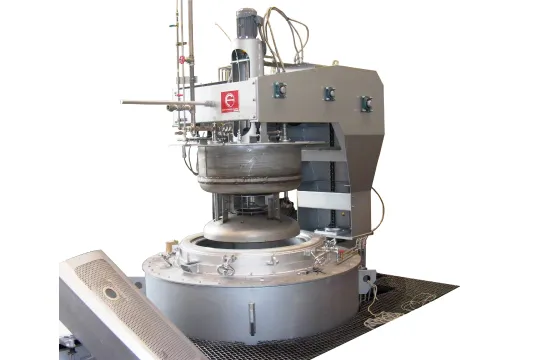
Specification
| Furnace type | Pit type |
| Effective dimension | φ900×H2500 |
| Temperature | 450~950℃ |
| Atmosphere | Nitrogen、Methanol decomposition gas、Propane gas |
| Workpiece | Metal material(Iron-based) |
| Application | Carburizing、quenching、tempering |
| Electric capacity | 240kW |
| Processing capacity | 3000kg/ch |
Features
- Due to the effective dimension of H2500, heat treatment of long parts is also possible.
- It is possible to generate carburizing gas from methanol inside the furnace for heat treatment.
- Changing the atmosphere gas is possible, allowing heat treatment of small quantities and various types.
Frequently Asked Questions:
Q: What are the differences between carburizing and high frequency induction hardening?
A: Both surface treatments are used to increase hardness and improve impact and wear resistance.
The difference is that carburizing is done in a furnace, while high frequency induction hardening is done externally using coils.
As a result, carburizing can process a larger number of parts at one time, whereas high-frequency induction hardening requires individual treatment of each part.
There are also differences in processing times between carburizing and high-frequency induction hardening.
Carburizing involves several hours of processing in the furnace to increase surface hardness through carbon diffusion.
The processing time must be adjusted based on the desired case depth.
On the other hand, high-frequency induction hardening completes the process in a shorter time compared to carburizing.
The coil applied electric current and heating time are used to adjust the case depth.
Q: What are the differences in materials used for carburizing and high frequency induction hardening?
A: Examples of materials used for carburizing are as follows:
- SCM415
- SCM420
- SNCM420
Examples of materials used for high-frequency induction hardening are as follows:
- SCM435
- SCM440
- S45C
- SK3
- SUJ2
- SUS420J2
- SUS440C etc
In general, as mentioned above, the choice of processing methods varies depending on the material, but there are exceptions.
For instance, with materials like SCM415, a combination of carburizing treatment and quenching followed by localized high-frequency induction hardening can be employed.
This method is chosen when there are specific areas where hardening is not desired.
Summary
Up to this point, we have explained the characteristics of carburizing treatment, how it differs from nitriding treatment, and the various types of treatments available.
In carburizing treatment, carbon from atmospheric gas is introduced into steel to increase surface hardness and improve wear resistance.
Since the internal structure remains unchanged, the steel retains its toughness, making it resistant to fracture even under bending stress. This results in improved mechanical properties such as wear resistance and fatigue strength.
However, due to the higher temperature required compared to nitriding, there is a possibility of greater deformation.
If you are faced with challenges related to the surface treatment of metal products, we strongly recommend that you consult a specialized heat treatment manufacturer.
Industrial furnace manufacturer, Sun Furnace, proposes custom-made atmosphere gas generation devices tailored to your application based on the know-how gained from manufacturing more than 1,500 industrial furnaces.
We also offer free technical consultations, so please feel free to contact us.
Learn more about Sunfurnace’s vacuum furnace
Explore Sunfurnace’s atmosphere furnace in detai

